Refine search
No keyword found to refine search
keywords EN
Places
Names
70 documents found
| 1 | 2 |
Documents per page :
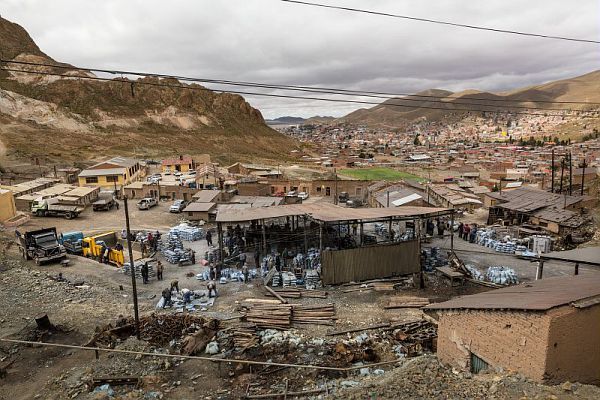
Bolivia - Oruro Carnival
Chris Huby / Le Pictorium
LePictorium_0174038.jpg
February 2017 - Bolivia / Oruro - SAN JOSE mine. OVERVIEW - At 5 km from the city of Oruro, the mine brings a large part of the local economy. Silver, tin and lead have been extracted from siceles. The carnival of Oruro is the biggest annual cultural event of Bolivia. Carnival celebrated in the city of Oruro, the capital of folklore of the country, it is part of the festival Ito in honor of the Uru people. "The Oruro Carnival" was inscribed in 2008 by UNESCO on the Representative List of the Intangible Cultural Heritage of Humanity.
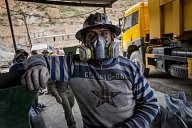
Bolivia - Oruro Carnival
Chris Huby / Le Pictorium
LePictorium_0174039.jpg
February 2017 - Bolivia / Oruro - SAN JOSE mine. Portrait of a miner wearing a mask to protect himself from various fumes and toxic waste. 5 km from the city of Oruro, the mine brings a large part of the local economy. Silver, tin and lead have been extracted from siceles. The carnival of Oruro is the biggest annual cultural event of Bolivia. Carnival celebrated in the city of Oruro, the capital of folklore of the country, it is part of the festival Ito in honor of the Uru people. "The Oruro Carnival" was inscribed in 2008 by UNESCO on the Representative List of the Intangible Cultural Heritage of Humanity.
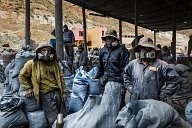
Bolivia - Oruro Carnival
Chris Huby / Le Pictorium
LePictorium_0174040.jpg
February 2017 - Bolivia / Oruro - SAN JOSE mine. Portrait of a miner wearing a mask to protect himself from various fumes and toxic waste. 5 km from the city of Oruro, the mine brings a large part of the local economy. Silver, tin and lead have been extracted from siceles. The carnival of Oruro is the biggest annual cultural event of Bolivia. Carnival celebrated in the city of Oruro, the capital of folklore of the country, it is part of the festival Ito in honor of the Uru people. "The Oruro Carnival" was inscribed in 2008 by UNESCO on the Representative List of the Intangible Cultural Heritage of Humanity.
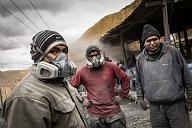
Bolivia - Oruro Carnival
Chris Huby / Le Pictorium
LePictorium_0174041.jpg
February 2017 - Bolivia / Oruro - SAN JOSE mine. Portrait of a miner wearing a mask to protect himself from various fumes and toxic waste. 5 km from the city of Oruro, the mine brings a large part of the local economy. Silver, tin and lead have been extracted from siceles. The carnival of Oruro is the biggest annual cultural event of Bolivia. Carnival celebrated in the city of Oruro, the capital of folklore of the country, it is part of the festival Ito in honor of the Uru people. "The Oruro Carnival" was inscribed in 2008 by UNESCO on the Representative List of the Intangible Cultural Heritage of Humanity.

Bolivia - Oruro Carnival
Chris Huby / Le Pictorium
LePictorium_0174042.jpg
February 2017 - Bolivia / Oruro - SAN JOSE mine. Portrait of a miner wearing a mask to protect himself from various fumes and toxic waste. 5 km from the city of Oruro, the mine brings a large part of the local economy. Silver, tin and lead have been extracted from siceles. The carnival of Oruro is the biggest annual cultural event of Bolivia. Carnival celebrated in the city of Oruro, the capital of folklore of the country, it is part of the festival Ito in honor of the Uru people. "The Oruro Carnival" was inscribed in 2008 by UNESCO on the Representative List of the Intangible Cultural Heritage of Humanity.
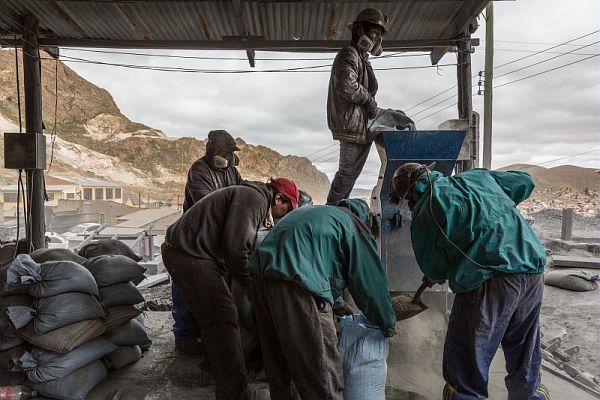
Bolivia - Oruro Carnival
Chris Huby / Le Pictorium
LePictorium_0174043.jpg
February 2017 - Bolivia / Oruro - SAN JOSE mine. Portrait in action of miners crushing minerals. 5 km from the city of Oruro, the mine brings a large part of the local economy. Silver, tin and lead have been extracted from siceles. The carnival of Oruro is the biggest annual cultural event of Bolivia. Carnival celebrated in the city of Oruro, the capital of folklore of the country, it is part of the festival Ito in honor of the Uru people. "The Oruro Carnival" was inscribed in 2008 by UNESCO on the Representative List of the Intangible Cultural Heritage of Humanity.
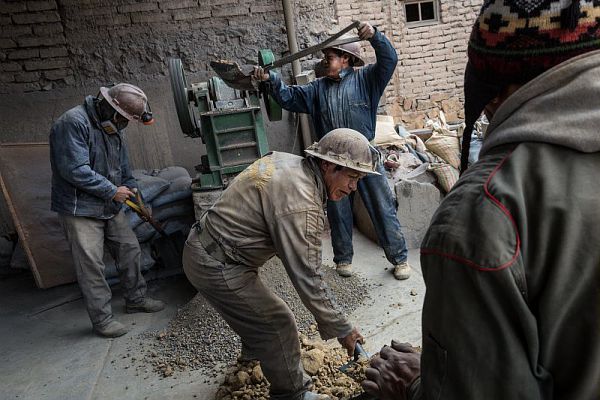
Bolivia - Oruro Carnival
Chris Huby / Le Pictorium
LePictorium_0174044.jpg
February 2017 - Bolivia / Oruro - SAN JOSE mine. Portrait in action of miners crushing minerals. 5 km from the city of Oruro, the mine brings a large part of the local economy. Silver, tin and lead have been extracted from siceles. The carnival of Oruro is the biggest annual cultural event of Bolivia. Carnival celebrated in the city of Oruro, the capital of folklore of the country, it is part of the festival Ito in honor of the Uru people. "The Oruro Carnival" was inscribed in 2008 by UNESCO on the Representative List of the Intangible Cultural Heritage of Humanity.
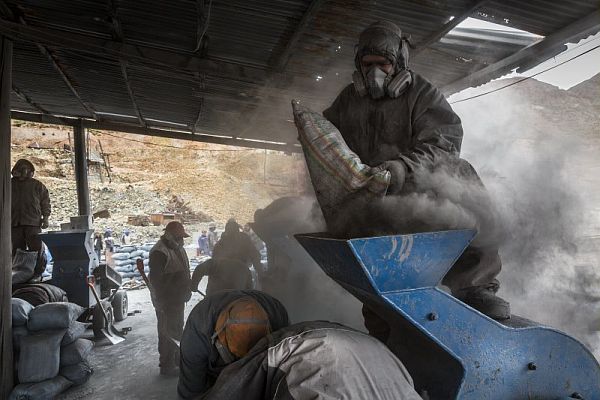
Bolivia - Oruro Carnival
Chris Huby / Le Pictorium
LePictorium_0174045.jpg
February 2017 - Bolivia / Oruro - SAN JOSE mine. Portrait in action of miners crushing minerals. 5 km from the city of Oruro, the mine brings a large part of the local economy. Silver, tin and lead have been extracted from siceles. The carnival of Oruro is the biggest annual cultural event of Bolivia. Carnival celebrated in the city of Oruro, the capital of folklore of the country, it is part of the festival Ito in honor of the Uru people. "The Oruro Carnival" was inscribed in 2008 by UNESCO on the Representative List of the Intangible Cultural Heritage of Humanity.
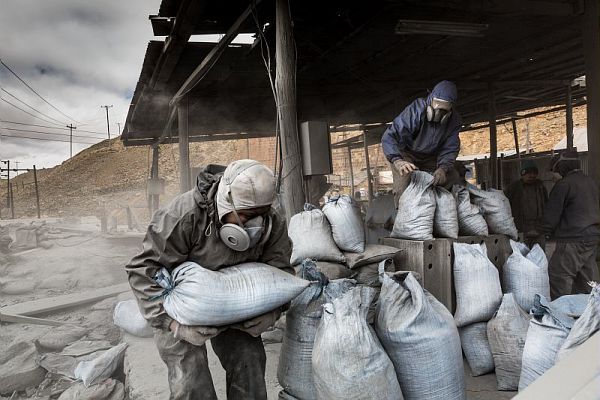
Bolivia - Oruro Carnival
Chris Huby / Le Pictorium
LePictorium_0174046.jpg
February 2017 - Bolivia / Oruro - SAN JOSE mine. Portrait in action of miners crushing minerals. 5 km from the city of Oruro, the mine brings a large part of the local economy. Silver, tin and lead have been extracted from siceles. The carnival of Oruro is the biggest annual cultural event of Bolivia. Carnival celebrated in the city of Oruro, the capital of folklore of the country, it is part of the festival Ito in honor of the Uru people. "The Oruro Carnival" was inscribed in 2008 by UNESCO on the Representative List of the Intangible Cultural Heritage of Humanity.
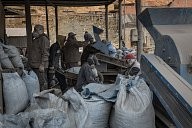
Bolivia - Oruro Carnival
Chris Huby / Le Pictorium
LePictorium_0174047.jpg
February 2017 - Bolivia / Oruro - SAN JOSE mine. Portrait in action of miners crushing minerals. 5 km from the city of Oruro, the mine brings a large part of the local economy. Silver, tin and lead have been extracted from siceles. The carnival of Oruro is the biggest annual cultural event of Bolivia. Carnival celebrated in the city of Oruro, the capital of folklore of the country, it is part of the festival Ito in honor of the Uru people. "The Oruro Carnival" was inscribed in 2008 by UNESCO on the Representative List of the Intangible Cultural Heritage of Humanity.
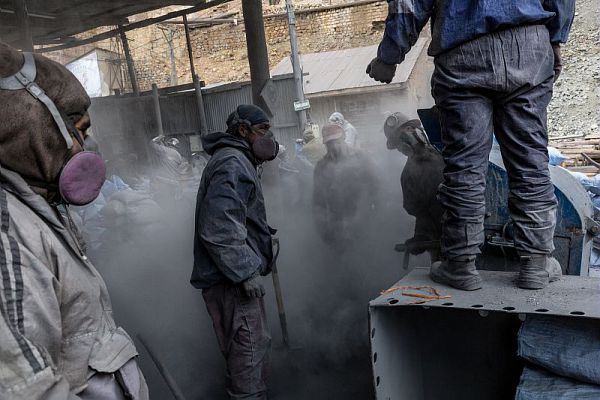
Bolivia - Oruro Carnival
Chris Huby / Le Pictorium
LePictorium_0174048.jpg
February 2017 - Bolivia / Oruro - SAN JOSE mine. Portrait in action of miners crushing minerals. 5 km from the city of Oruro, the mine brings a large part of the local economy. Silver, tin and lead have been extracted from siceles. The carnival of Oruro is the biggest annual cultural event of Bolivia. Carnival celebrated in the city of Oruro, the capital of folklore of the country, it is part of the festival Ito in honor of the Uru people. "The Oruro Carnival" was inscribed in 2008 by UNESCO on the Representative List of the Intangible Cultural Heritage of Humanity.
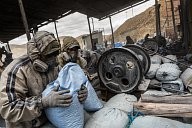
Bolivia - Oruro Carnival
Chris Huby / Le Pictorium
LePictorium_0174049.jpg
February 2017 - Bolivia / Oruro - SAN JOSE mine. Portrait in action of miners crushing minerals. 5 km from the city of Oruro, the mine brings a large part of the local economy. Silver, tin and lead have been extracted from siceles. The carnival of Oruro is the biggest annual cultural event of Bolivia. Carnival celebrated in the city of Oruro, the capital of folklore of the country, it is part of the festival Ito in honor of the Uru people. "The Oruro Carnival" was inscribed in 2008 by UNESCO on the Representative List of the Intangible Cultural Heritage of Humanity.

Bolivia - Oruro Carnival
Chris Huby / Le Pictorium
LePictorium_0174050.jpg
February 2017 - Bolivia / Oruro - SAN JOSE mine. Portrait in action of miners crushing minerals. 5 km from the city of Oruro, the mine brings a large part of the local economy. Silver, tin and lead have been extracted from siceles. The carnival of Oruro is the biggest annual cultural event of Bolivia. Carnival celebrated in the city of Oruro, the capital of folklore of the country, it is part of the festival Ito in honor of the Uru people. "The Oruro Carnival" was inscribed in 2008 by UNESCO on the Representative List of the Intangible Cultural Heritage of Humanity.
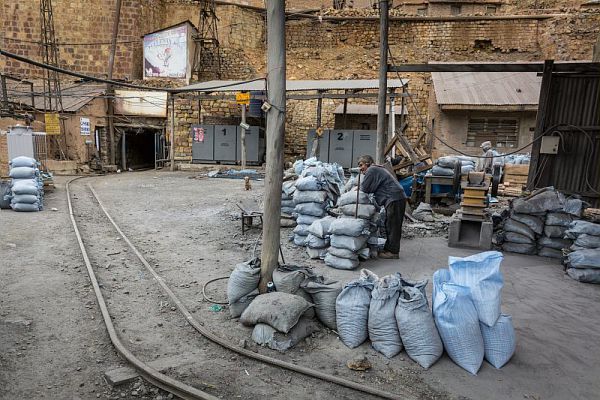
Bolivia - Oruro Carnival
Chris Huby / Le Pictorium
LePictorium_0174051.jpg
February 2017 - Bolivia / Oruro - SAN JOSE mine. The entrance to the main mine. 5 km from the city of Oruro, the mine brings a large part of the local economy. Silver, tin and lead have been extracted from siceles. The carnival of Oruro is the biggest annual cultural event of Bolivia. Carnival celebrated in the city of Oruro, the capital of folklore of the country, it is part of the festival Ito in honor of the Uru people. "The Oruro Carnival" was inscribed in 2008 by UNESCO on the Representative List of the Intangible Cultural Heritage of Humanity.
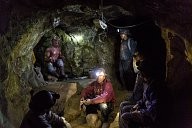
Bolivia - Oruro Carnival
Chris Huby / Le Pictorium
LePictorium_0174052.jpg
February 2017 - Bolivia / Oruro - SAN JOSE mine. Inside the mine, a gallery is dedicated to the devil (EL TIO), a belief from ancestral history. El Tio ("The Uncle") is a god of the underworld and hell according to a popular belief. Located in the Cerro Rico near Potosí in Bolivia, several statues representing El Tio receive offerings (eg cigarettes, coca leaves, candies and alcohol), especially from minors to obtain kindness. 5 km from the city of Oruro, the mine brings a large part of the local economy. Silver, tin and lead have been extracted from siceles. The carnival of Oruro is the biggest annual cultural event of Bolivia. Carnival celebrated in the city of Oruro, the capital of folklore of the country, it is part of the festival Ito in honor of the Uru people. "The Oruro Carnival" was inscribed in 2008 by UNESCO on the Representative List of the Intangible Cultural Heritage of Humanity.
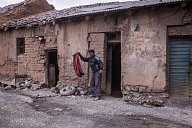
Bolivia - Oruro Carnival
Chris Huby / Le Pictorium
LePictorium_0174053.jpg
February 2017 - Bolivia / Oruro - Portrait of a miner in front of his house, shaking his jacket blackened by his work. . A few days before the official carnival, the miners march from the bottom of the hill to the mine for hours, gathering their own ancestral beliefs to the Christian rites imported by the Spaniards. Drinks and folklore spread for hours. This parade remains relatively poor, the modest level of minors, and does not include directly in the official carnival. The carnival of Oruro is the biggest annual cultural event of Bolivia. Carnival celebrated in the city of Oruro, the capital of folklore of the country, it is part of the festival Ito in honor of the Uru people. "The Oruro Carnival" was inscribed in 2008 by UNESCO on the Representative List of the Intangible Cultural Heritage of Humanity.
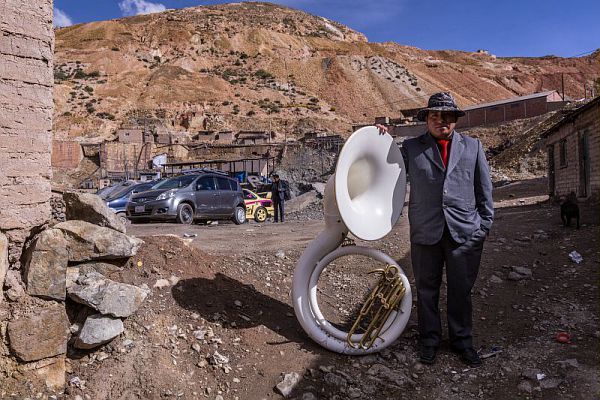
Bolivia - Oruro Carnival
Chris Huby / Le Pictorium
LePictorium_0174054.jpg
February 2017 - Bolivia / Oruro - Portrait of a Banda musician hired by the miners of San José - A few days before the official carnival, miners march from the foot of the hill to the mine for hours, gathering their own beliefs ancestral to the Christian rites imported by the Spaniards. Drinks and folklore spread for hours. This parade remains relatively poor, the modest level of minors, and does not include directly in the official carnival. The carnival of Oruro is the biggest annual cultural event of Bolivia. Carnival celebrated in the city of Oruro, the capital of folklore of the country, it is part of the festival Ito in honor of the Uru people. "The Oruro Carnival" was inscribed in 2008 by UNESCO on the Representative List of the Intangible Cultural Heritage of Humanity.
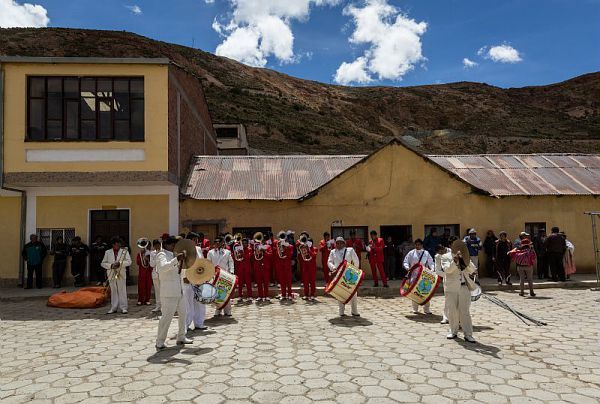
Bolivia - Oruro Carnival
Chris Huby / Le Pictorium
LePictorium_0174055.jpg
February 2017 - Bolivia / Oruro - Shooting Banda musicians A few days before the official carnival, the miners march from the foot of the hill to the mine for hours, gathering their own ancestral beliefs in the Christian rituals imported by Muslims. Spanish. Drinks and folklore spread for hours. This parade remains relatively poor, the modest level of minors, and does not include directly in the official carnival. The carnival of Oruro is the biggest annual cultural event of Bolivia. Carnival celebrated in the city of Oruro, the capital of folklore of the country, it is part of the festival Ito in honor of the Uru people. "The Oruro Carnival" was inscribed in 2008 by UNESCO on the Representative List of the Intangible Cultural Heritage of Humanity.
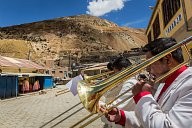
Bolivia - Oruro Carnival
Chris Huby / Le Pictorium
LePictorium_0174056.jpg
February 2017 - Bolivia / Oruro - Shooting Banda musicians A few days before the official carnival, the miners march from the foot of the hill to the mine for hours, gathering their own ancestral beliefs in the Christian rituals imported by Muslims. Spanish. Drinks and folklore spread for hours. This parade remains relatively poor, the modest level of minors, and does not include directly in the official carnival. The carnival of Oruro is the biggest annual cultural event of Bolivia. Carnival celebrated in the city of Oruro, the capital of folklore of the country, it is part of the festival Ito in honor of the Uru people. "The Oruro Carnival" was inscribed in 2008 by UNESCO on the Representative List of the Intangible Cultural Heritage of Humanity.

Bolivia - Oruro Carnival
Chris Huby / Le Pictorium
LePictorium_0174057.jpg
February 2017 - Bolivia / Oruro - Minors bless their work tools, here their trucks. A few days before the official carnival, the miners march from the bottom of the hill to the mine for hours, gathering their own ancestral beliefs to the Christian rites imported by the Spaniards. Drinks and folklore spread for hours. This parade remains relatively poor, the modest level of minors, and does not include directly in the official carnival. The carnival of Oruro is the biggest annual cultural event of Bolivia. Carnival celebrated in the city of Oruro, the capital of folklore of the country, it is part of the festival Ito in honor of the Uru people. "The Oruro Carnival" was inscribed in 2008 by UNESCO on the Representative List of the Intangible Cultural Heritage of Humanity.

Bolivia - Oruro Carnival
Chris Huby / Le Pictorium
LePictorium_0174058.jpg
February 2017 - Bolivia / Oruro - Minors bless their work tools, here their trucks. A few days before the official carnival, the miners march from the bottom of the hill to the mine for hours, gathering their own ancestral beliefs to the Christian rites imported by the Spaniards. Drinks and folklore spread for hours. This parade remains relatively poor, the modest level of minors, and does not include directly in the official carnival. The carnival of Oruro is the biggest annual cultural event of Bolivia. Carnival celebrated in the city of Oruro, the capital of folklore of the country, it is part of the festival Ito in honor of the Uru people. "The Oruro Carnival" was inscribed in 2008 by UNESCO on the Representative List of the Intangible Cultural Heritage of Humanity.
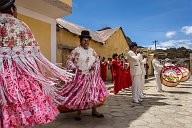
Bolivia - Oruro Carnival
Chris Huby / Le Pictorium
LePictorium_0174059.jpg
February 2017 - Bolivia / Oruro - Dancers train in front of the San José mine office - A few days before the official carnival, the miners march from the bottom of the hill to the mine for hours, gathering their own beliefs ancestral to the Christian rites imported by the Spaniards. Drinks and folklore spread for hours. This parade remains relatively poor, the modest level of minors, and does not include directly in the official carnival. The carnival of Oruro is the biggest annual cultural event of Bolivia. Carnival celebrated in the city of Oruro, the capital of folklore of the country, it is part of the festival Ito in honor of the Uru people. "The Oruro Carnival" was inscribed in 2008 by UNESCO on the Representative List of the Intangible Cultural Heritage of Humanity.

Bolivia - Oruro Carnival
Chris Huby / Le Pictorium
LePictorium_0174060.jpg
February 2017 - Bolivia / Oruro - Minors get dressed before the parade - A few days before the official carnival, the miners march from the bottom of the hill to the mine for hours, gathering their own ancestral beliefs to the Christian rites imported by the Spaniards. Drinks and folklore spread for hours. This parade remains relatively poor, the modest level of minors, and does not include directly in the official carnival. The carnival of Oruro is the biggest annual cultural event of Bolivia. Carnival celebrated in the city of Oruro, the capital of folklore of the country, it is part of the festival Ito in honor of the Uru people. "The Oruro Carnival" was inscribed in 2008 by UNESCO on the Representative List of the Intangible Cultural Heritage of Humanity.
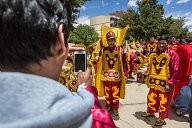
Bolivia - Oruro Carnival
Chris Huby / Le Pictorium
LePictorium_0174061.jpg
February 2017 - Bolivia / Oruro - A costumed miner takes a picture of himself by one of his friends - A few days before the official carnival, miners march from the foot of the hill to the mine for hours, regrouping their own ancestral beliefs to the Christian rites imported by the Spaniards. Drinks and folklore spread for hours. This parade remains relatively poor, the modest level of minors, and does not include directly in the official carnival. The carnival of Oruro is the biggest annual cultural event of Bolivia. Carnival celebrated in the city of Oruro, the capital of folklore of the country, it is part of the festival Ito in honor of the Uru people. "The Oruro Carnival" was inscribed in 2008 by UNESCO on the Representative List of the Intangible Cultural Heritage of Humanity.

Bolivia - Oruro Carnival
Chris Huby / Le Pictorium
LePictorium_0174062.jpg
February 2017 - Bolivia / Oruro - Dancers drink before the parade - A few days before the official carnival, the miners march down the hill to the mine for hours, gathering their own ancestral beliefs to the Christian rites imported by the Spanish . Drinks and folklore spread for hours. This parade remains relatively poor, the modest level of minors, and does not include directly in the official carnival. The carnival of Oruro is the biggest annual cultural event of Bolivia. Carnival celebrated in the city of Oruro, the capital of folklore of the country, it is part of the festival Ito in honor of the Uru people. "The Oruro Carnival" was inscribed in 2008 by UNESCO on the Representative List of the Intangible Cultural Heritage of Humanity.

Bolivia - Oruro Carnival
Chris Huby / Le Pictorium
LePictorium_0174063.jpg
February 2017 - Bolivia / Oruro - A dancer dresses before his parade - A few days before the official carnival, the miners march from the bottom of the hill to the mine for hours, gathering their own ancestral beliefs to the Christian rites imported by the Spaniards. Drinks and folklore spread for hours. This parade remains relatively poor, the modest level of minors, and does not include directly in the official carnival. The carnival of Oruro is the biggest annual cultural event of Bolivia. Carnival celebrated in the city of Oruro, the capital of folklore of the country, it is part of the festival Ito in honor of the Uru people. "The Oruro Carnival" was inscribed in 2008 by UNESCO on the Representative List of the Intangible Cultural Heritage of Humanity.
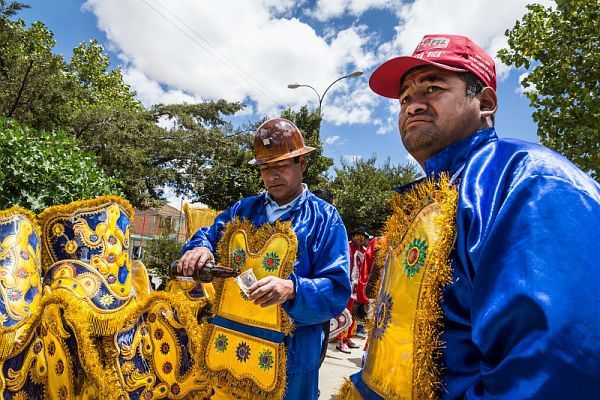
Bolivia - Oruro Carnival
Chris Huby / Le Pictorium
LePictorium_0174064.jpg
February 2017 - Bolivia / Oruro - Costumed miners drink beers before going on a parade - A few days before the official carnival, the miners march from the foot of the hill to the mine for hours, gathering their own ancestral beliefs with the rites Christians imported by the Spaniards. Drinks and folklore spread for hours. This parade remains relatively poor, the modest level of minors, and does not include directly in the official carnival. The carnival of Oruro is the biggest annual cultural event of Bolivia. Carnival celebrated in the city of Oruro, the capital of folklore of the country, it is part of the festival Ito in honor of the Uru people. "The Oruro Carnival" was inscribed in 2008 by UNESCO on the Representative List of the Intangible Cultural Heritage of Humanity.
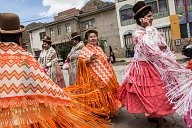
Bolivia - Oruro Carnival
Chris Huby / Le Pictorium
LePictorium_0174065.jpg
February 2017 - Bolivia / Oruro - Dancers, companions and family of miners, parade by dasant - A few days before the official carnival, the miners march from the foot of the hill to the mine for hours, gathering their own ancestral beliefs Christian rites imported by the Spaniards. Drinks and folklore spread for hours. This parade remains relatively poor, the modest level of minors, and does not include directly in the official carnival. The carnival of Oruro is the biggest annual cultural event of Bolivia. Carnival celebrated in the city of Oruro, the capital of folklore of the country, it is part of the festival Ito in honor of the Uru people. "The Oruro Carnival" was inscribed in 2008 by UNESCO on the Representative List of the Intangible Cultural Heritage of Humanity.
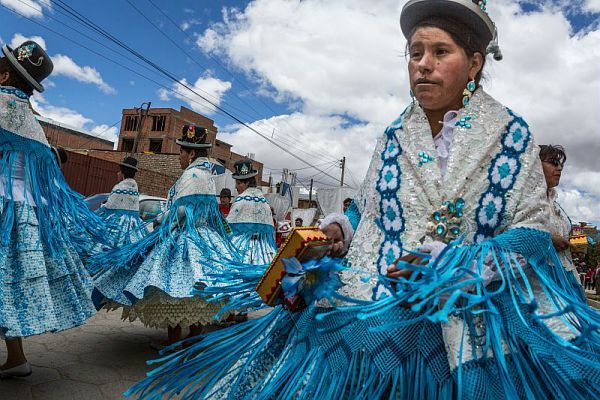
Bolivia - Oruro Carnival
Chris Huby / Le Pictorium
LePictorium_0174066.jpg
February 2017 - Bolivia / Oruro - Dancers, companions and family of miners, parade by dasant - A few days before the official carnival, the miners march from the foot of the hill to the mine for hours, gathering their own ancestral beliefs Christian rites imported by the Spaniards. Drinks and folklore spread for hours. This parade remains relatively poor, the modest level of minors, and does not include directly in the official carnival. The carnival of Oruro is the biggest annual cultural event of Bolivia. Carnival celebrated in the city of Oruro, the capital of folklore of the country, it is part of the festival Ito in honor of the Uru people. "The Oruro Carnival" was inscribed in 2008 by UNESCO on the Representative List of the Intangible Cultural Heritage of Humanity.
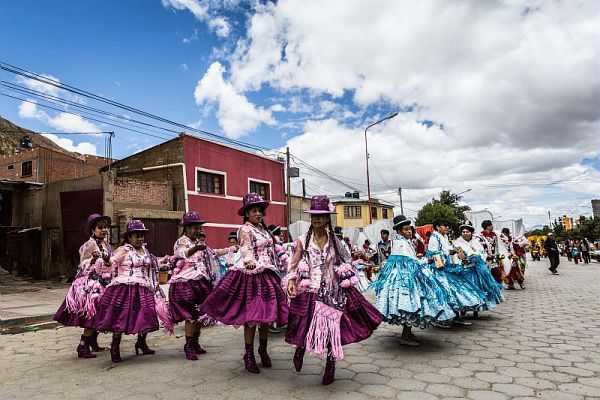
Bolivia - Oruro Carnival
Chris Huby / Le Pictorium
LePictorium_0174067.jpg
February 2017 - Bolivia / Oruro - Dancers, companions and family of miners, parade by dasant - A few days before the official carnival, the miners march from the foot of the hill to the mine for hours, gathering their own ancestral beliefs Christian rites imported by the Spaniards. Drinks and folklore spread for hours. This parade remains relatively poor, the modest level of minors, and does not include directly in the official carnival. The carnival of Oruro is the biggest annual cultural event of Bolivia. Carnival celebrated in the city of Oruro, the capital of folklore of the country, it is part of the festival Ito in honor of the Uru people. "The Oruro Carnival" was inscribed in 2008 by UNESCO on the Representative List of the Intangible Cultural Heritage of Humanity.

Bolivia - Oruro Carnival
Chris Huby / Le Pictorium
LePictorium_0174068.jpg
February 2017 - Bolivia / Oruro - Miners march in front of the San José mine hills - A few days before the official carnival, the miners march down the hill to the mine for hours, gathering their own ancestral beliefs in the city. Christian rites imported by the Spaniards. Drinks and folklore spread for hours. This parade remains relatively poor, the modest level of minors, and does not include directly in the official carnival. The carnival of Oruro is the biggest annual cultural event of Bolivia. Carnival celebrated in the city of Oruro, the capital of folklore of the country, it is part of the festival Ito in honor of the Uru people. "The Oruro Carnival" was inscribed in 2008 by UNESCO on the Representative List of the Intangible Cultural Heritage of Humanity.
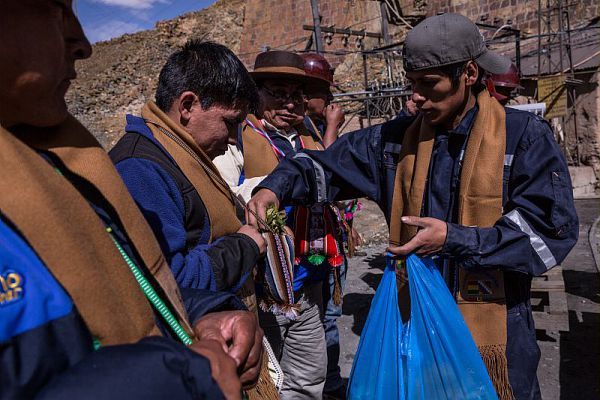
Bolivia - Oruro Carnival
Chris Huby / Le Pictorium
LePictorium_0174069.jpg
February 2017 - Bolivia / Oruro - A miner distributes sheets of COCA for the upcoming party. On Friday, carnival eve, the miners of San José hired a banda (musicians) and a spiritual guide (Yatari) to follow their ancestral ceremony which aims to make offerings to the devil (El Tio) to obtain his benevolence - El Tio ("The Uncle") is a god of the underworld and hell according to a popular belief. The carnival of Oruro is the biggest annual cultural event of Bolivia. Carnival celebrated in the city of Oruro, the capital of folklore of the country, it is part of the festival Ito in honor of the Uru people. "The Oruro Carnival" was inscribed in 2008 by UNESCO on the Representative List of the Intangible Cultural Heritage of Humanity.
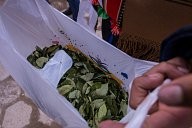
Bolivia - Oruro Carnival
Chris Huby / Le Pictorium
LePictorium_0174070.jpg
February 2017 - Bolivia / Oruro - Close-up of a miner's bag filled with COCA leaves - On Friday, carnival eve, San José miners hired a banda (musicians) and a spiritual guide (Yatari) to follow their ancestral ceremony that aims to make offerings to the devil (El Tio) to obtain his benevolence - El Tio ("The Uncle") is a god of the underworld and hell according to a popular belief. The carnival of Oruro is the biggest annual cultural event of Bolivia. Carnival celebrated in the city of Oruro, the capital of folklore of the country, it is part of the festival Ito in honor of the Uru people. "The Oruro Carnival" was inscribed in 2008 by UNESCO on the Representative List of the Intangible Cultural Heritage of Humanity.
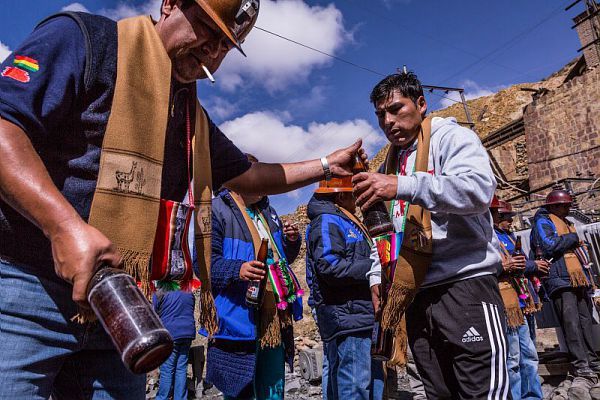
Bolivia - Oruro Carnival
Chris Huby / Le Pictorium
LePictorium_0174071.jpg
February 2017 - Bolivia / Oruro - Juveniles distribute and drink beers for hours before ancestral ceremony - On Fridays, carnival eve, miners in San José hired a banda (musicians) and a spiritual guide (Yatari) for follow their ancestral ceremony which aims to make offerings to the devil (El Tio) to obtain his benevolence - El Tio ("The Uncle") is a god of the underworld and hell according to a popular belief. The carnival of Oruro is the biggest annual cultural event of Bolivia. Carnival celebrated in the city of Oruro, the capital of folklore of the country, it is part of the festival Ito in honor of the Uru people. "The Oruro Carnival" was inscribed in 2008 by UNESCO on the Representative List of the Intangible Cultural Heritage of Humanity.
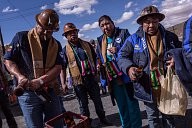
Bolivia - Oruro Carnival
Chris Huby / Le Pictorium
LePictorium_0174072.jpg
February 2017 - Bolivia / Oruro - Juveniles distribute and drink beers for hours before ancestral ceremony - On Fridays, carnival eve, miners in San José hired a banda (musicians) and a spiritual guide (Yatari) for follow their ancestral ceremony which aims to make offerings to the devil (El Tio) to obtain his benevolence - El Tio ("The Uncle") is a god of the underworld and hell according to a popular belief. The carnival of Oruro is the biggest annual cultural event of Bolivia. Carnival celebrated in the city of Oruro, the capital of folklore of the country, it is part of the festival Ito in honor of the Uru people. "The Oruro Carnival" was inscribed in 2008 by UNESCO on the Representative List of the Intangible Cultural Heritage of Humanity.
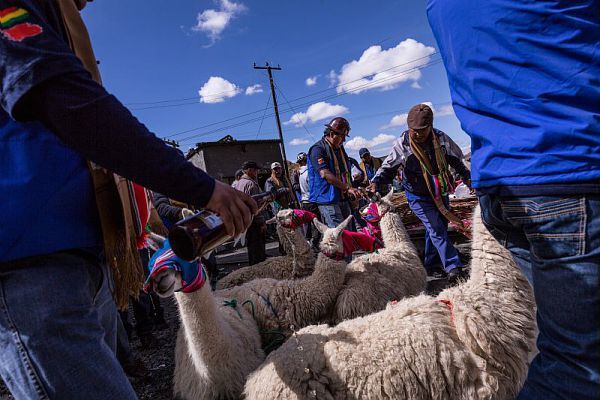
Bolivia - Oruro Carnival
Chris Huby / Le Pictorium
LePictorium_0174073.jpg
February 2017 - Bolivia / Oruro - Miners pour alcohol and beer on the llamas that will be sacrificed - On Friday, carnival eve, the miners of San José hired a banda (musicians) and a spiritual guide ( the Yatari) to follow their ancestral ceremony which aims at making offerings to the devil (El Tio) to obtain his benevolence - El Tio ("The Uncle") is a god of the underworld and hell according to a popular belief. The carnival of Oruro is the biggest annual cultural event of Bolivia. Carnival celebrated in the city of Oruro, the capital of folklore of the country, it is part of the festival Ito in honor of the Uru people. "The Oruro Carnival" was inscribed in 2008 by UNESCO on the Representative List of the Intangible Cultural Heritage of Humanity.
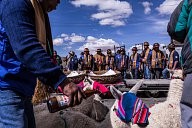
Bolivia - Oruro Carnival
Chris Huby / Le Pictorium
LePictorium_0174074.jpg
February 2017 - Bolivia / Oruro - Miners pour alcohol and beer on the llamas that will be sacrificed - On Friday, carnival eve, the miners of San José hired a banda (musicians) and a spiritual guide ( the Yatari) to follow their ancestral ceremony which aims at making offerings to the devil (El Tio) to obtain his benevolence - El Tio ("The Uncle") is a god of the underworld and hell according to a popular belief. The carnival of Oruro is the biggest annual cultural event of Bolivia. Carnival celebrated in the city of Oruro, the capital of folklore of the country, it is part of the festival Ito in honor of the Uru people. "The Oruro Carnival" was inscribed in 2008 by UNESCO on the Representative List of the Intangible Cultural Heritage of Humanity.
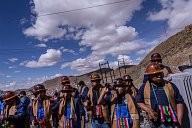
Bolivia - Oruro Carnival
Chris Huby / Le Pictorium
LePictorium_0174075.jpg
February 2017 - Bolivia / Oruro - SAN JOSE miners' group portrait - On Friday, carnival eve, the miners of San José hired a banda (musicians) and a spiritual guide (Yatari) to follow their ancestral ceremony to make offerings to the devil (El Tio) to obtain his benevolence - El Tio ("The Uncle") is a god of the underworld and hell according to a popular belief. The carnival of Oruro is the biggest annual cultural event of Bolivia. Carnival celebrated in the city of Oruro, the capital of folklore of the country, it is part of the festival Ito in honor of the Uru people. "The Oruro Carnival" was inscribed in 2008 by UNESCO on the Representative List of the Intangible Cultural Heritage of Humanity.
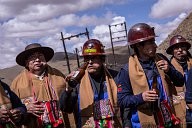
Bolivia - Oruro Carnival
Chris Huby / Le Pictorium
LePictorium_0174076.jpg
February 2017 - Bolivia / Oruro - SAN JOSE miners' group portrait - On Friday, carnival eve, the miners of San José hired a banda (musicians) and a spiritual guide (Yatari) to follow their ancestral ceremony to make offerings to the devil (El Tio) to obtain his benevolence - El Tio ("The Uncle") is a god of the underworld and hell according to a popular belief. The carnival of Oruro is the biggest annual cultural event of Bolivia. Carnival celebrated in the city of Oruro, the capital of folklore of the country, it is part of the festival Ito in honor of the Uru people. "The Oruro Carnival" was inscribed in 2008 by UNESCO on the Representative List of the Intangible Cultural Heritage of Humanity.
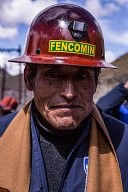
Bolivia - Oruro Carnival
Chris Huby / Le Pictorium
LePictorium_0174077.jpg
February 2017 - Bolivia / Oruro - Portrait of one of the San José miners - On Friday, carnival eve, the miners of San José hired a banda (musicians) and a spiritual guide (Yatari) to follow their ancestral ceremony which aims to make offerings to the devil (El Tio) to obtain his benevolence - El Tio ("The Uncle") is a god of the underworld and hell according to a popular belief. The carnival of Oruro is the biggest annual cultural event of Bolivia. Carnival celebrated in the city of Oruro, the capital of folklore of the country, it is part of the festival Ito in honor of the Uru people. "The Oruro Carnival" was inscribed in 2008 by UNESCO on the Representative List of the Intangible Cultural Heritage of Humanity.

Bolivia - Oruro Carnival
Chris Huby / Le Pictorium
LePictorium_0174078.jpg
February 2017 - Bolivia / Oruro - Portrait of one of the San José miners - On Friday, carnival eve, the miners of San José hired a banda (musicians) and a spiritual guide (Yatari) to follow their ancestral ceremony which aims to make offerings to the devil (El Tio) to obtain his benevolence - El Tio ("The Uncle") is a god of the underworld and hell according to a popular belief. The carnival of Oruro is the biggest annual cultural event of Bolivia. Carnival celebrated in the city of Oruro, the capital of folklore of the country, it is part of the festival Ito in honor of the Uru people. "The Oruro Carnival" was inscribed in 2008 by UNESCO on the Representative List of the Intangible Cultural Heritage of Humanity.
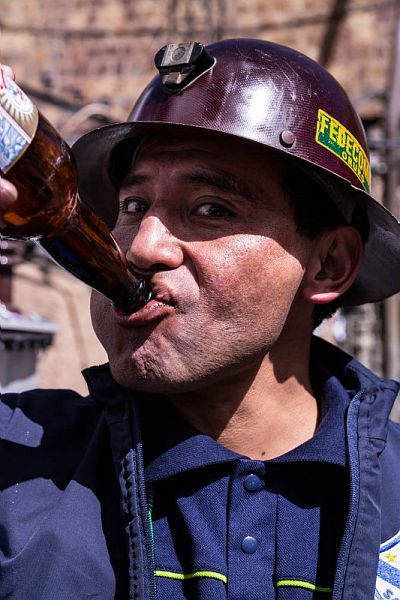
Bolivia - Oruro Carnival
Chris Huby / Le Pictorium
LePictorium_0174079.jpg
February 2017 - Bolivia / Oruro - Portrait of one of the San José miners - On Friday, carnival eve, the miners of San José hired a banda (musicians) and a spiritual guide (Yatari) to follow their ancestral ceremony which aims to make offerings to the devil (El Tio) to obtain his benevolence - El Tio ("The Uncle") is a god of the underworld and hell according to a popular belief. The carnival of Oruro is the biggest annual cultural event of Bolivia. Carnival celebrated in the city of Oruro, the capital of folklore of the country, it is part of the festival Ito in honor of the Uru people. "The Oruro Carnival" was inscribed in 2008 by UNESCO on the Representative List of the Intangible Cultural Heritage of Humanity.
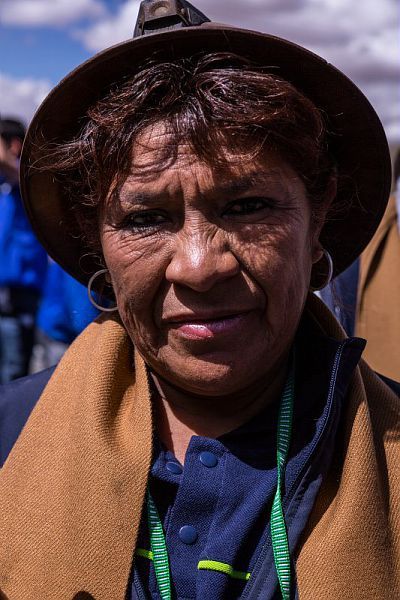
Bolivia - Oruro Carnival
Chris Huby / Le Pictorium
LePictorium_0174080.jpg
February 2017 - Bolivia / Oruro - Portrait of one of the San José miners - On Friday, carnival eve, the miners of San José hired a banda (musicians) and a spiritual guide (Yatari) to follow their ancestral ceremony which aims to make offerings to the devil (El Tio) to obtain his benevolence - El Tio ("The Uncle") is a god of the underworld and hell according to a popular belief. The carnival of Oruro is the biggest annual cultural event of Bolivia. Carnival celebrated in the city of Oruro, the capital of folklore of the country, it is part of the festival Ito in honor of the Uru people. "The Oruro Carnival" was inscribed in 2008 by UNESCO on the Representative List of the Intangible Cultural Heritage of Humanity.
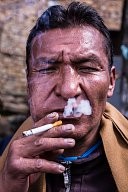
Bolivia - Oruro Carnival
Chris Huby / Le Pictorium
LePictorium_0174081.jpg
February 2017 - Bolivia / Oruro - Portrait of one of the San José miners - On Friday, carnival eve, the miners of San José hired a banda (musicians) and a spiritual guide (Yatari) to follow their ancestral ceremony which aims to make offerings to the devil (El Tio) to obtain his benevolence - El Tio ("The Uncle") is a god of the underworld and hell according to a popular belief. The carnival of Oruro is the biggest annual cultural event of Bolivia. Carnival celebrated in the city of Oruro, the capital of folklore of the country, it is part of the festival Ito in honor of the Uru people. "The Oruro Carnival" was inscribed in 2008 by UNESCO on the Representative List of the Intangible Cultural Heritage of Humanity.
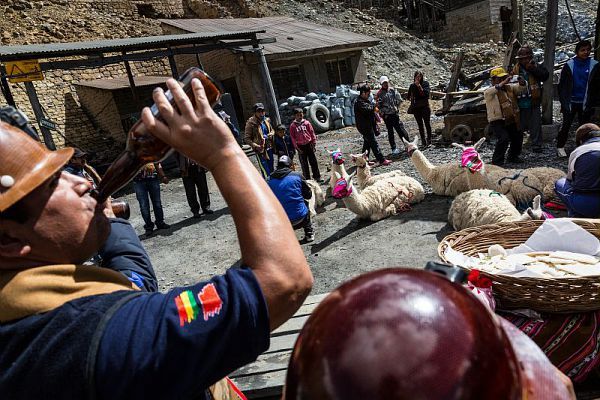
Bolivia - Oruro Carnival
Chris Huby / Le Pictorium
LePictorium_0174082.jpg
February 2017 - Bolivia / Oruro - Miners drink around llamas that will be sacrificed at their ceremony - Fridays of San José have hired a banda (musicians) and a spiritual guide (Yatari) follow their ancestral ceremony which aims to make offerings to the devil (El Tio) to obtain his benevolence - El Tio ("The Uncle") is a god of the underworld and hell according to a popular belief. The carnival of Oruro is the biggest annual cultural event of Bolivia. Carnival celebrated in the city of Oruro, the capital of folklore of the country, it is part of the festival Ito in honor of the Uru people. "The Oruro Carnival" was inscribed in 2008 by UNESCO on the Representative List of the Intangible Cultural Heritage of Humanity.
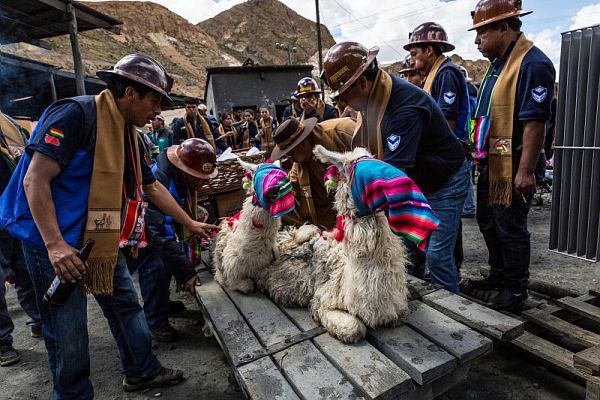
Bolivia - Oruro Carnival
Chris Huby / Le Pictorium
LePictorium_0174083.jpg
February 2017 - Bolivia / Oruro - The miners take the llamas that will be sacrificed in the San José mine - The carnival eve on Friday, the miners of San José have engaged a banda (musicians) and a spiritual guide (the Yatari) to follow their ancestral ceremony which aims at making offerings to the devil (El Tio) to obtain his benevolence - El Tio ("The Uncle") is a god of the underworld and hell according to a popular belief. The carnival of Oruro is the biggest annual cultural event of Bolivia. Carnival celebrated in the city of Oruro, the capital of folklore of the country, it is part of the festival Ito in honor of the Uru people. "The Oruro Carnival" was inscribed in 2008 by UNESCO on the Representative List of the Intangible Cultural Heritage of Humanity.
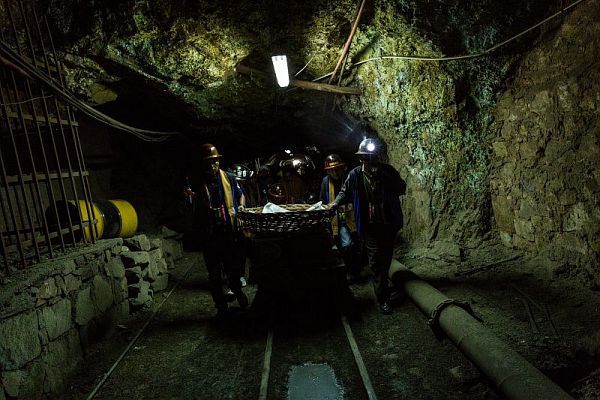
Bolivia - Oruro Carnival
Chris Huby / Le Pictorium
LePictorium_0174084.jpg
February 2017 - Bolivia / Oruro - Miners enter San José with offerings on a wagon - On Friday, carnival eve, the miners of San José hired a banda (musicians) and a spiritual guide (Yatari) to follow their ancestral ceremony that aims to make offerings to the devil (El Tio) to obtain his benevolence - El Tio ("The Uncle") is a god of the underworld and hell according to a popular belief. The carnival of Oruro is the biggest annual cultural event of Bolivia. Carnival celebrated in the city of Oruro, the capital of folklore of the country, it is part of the festival Ito in honor of the Uru people. "The Oruro Carnival" was inscribed in 2008 by UNESCO on the Representative List of the Intangible Cultural Heritage of Humanity.
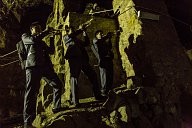
Bolivia - Oruro Carnival
Chris Huby / Le Pictorium
LePictorium_0174085.jpg
February 2017 - Bolivia / Oruro - Musicians play with their orchestra in the San José mine - On Friday, carnival eve, the miners of San José hired a banda (musicians) and a spiritual guide (Yatari) to follow their ancestral ceremony that aims to make offerings to the devil (El Tio) to obtain his benevolence - El Tio ("The Uncle") is a god of the underworld and hell according to a popular belief. The carnival of Oruro is the biggest annual cultural event of Bolivia. Carnival celebrated in the city of Oruro, the capital of folklore of the country, it is part of the festival Ito in honor of the Uru people. "The Oruro Carnival" was inscribed in 2008 by UNESCO on the Representative List of the Intangible Cultural Heritage of Humanity.
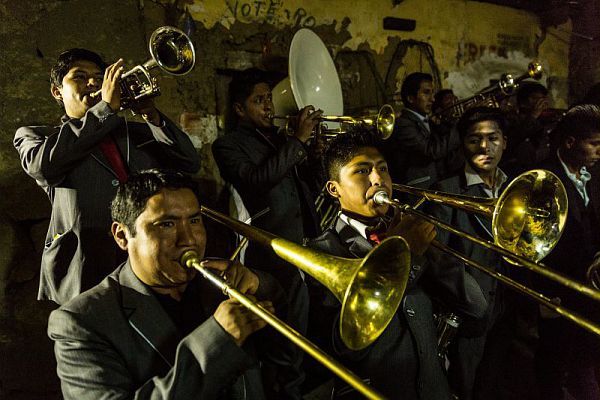
Bolivia - Oruro Carnival
Chris Huby / Le Pictorium
LePictorium_0174086.jpg
February 2017 - Bolivia / Oruro - Musicians play with their orchestra in the San José mine - On Friday, carnival eve, the miners of San José hired a banda (musicians) and a spiritual guide (Yatari) to follow their ancestral ceremony that aims to make offerings to the devil (El Tio) to obtain his benevolence - El Tio ("The Uncle") is a god of the underworld and hell according to a popular belief. The carnival of Oruro is the biggest annual cultural event of Bolivia. Carnival celebrated in the city of Oruro, the capital of folklore of the country, it is part of the festival Ito in honor of the Uru people. "The Oruro Carnival" was inscribed in 2008 by UNESCO on the Representative List of the Intangible Cultural Heritage of Humanity.
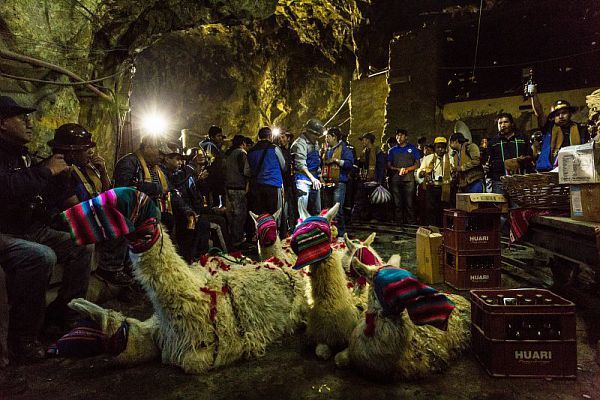
Bolivia - Oruro Carnival
Chris Huby / Le Pictorium
LePictorium_0174087.jpg
February 2017 - Bolivia / Oruro - Miners surround llamas ready to be sacrificed for the devil in their mine - On Friday, carnival eve, miners in San José hired a banda (musicians) and spiritual guide (Yatari) to follow their ancestral ceremony which aims at making offerings to the devil (El Tio) to obtain its benevolence - El Tio ("The Uncle") is a god of the underworld and hell according to a popular belief. The carnival of Oruro is the biggest annual cultural event of Bolivia. Carnival celebrated in the city of Oruro, the capital of folklore of the country, it is part of the festival Ito in honor of the Uru people. "The Oruro Carnival" was inscribed in 2008 by UNESCO on the Representative List of the Intangible Cultural Heritage of Humanity.
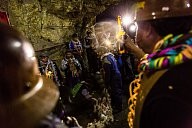
Bolivia - Oruro Carnival
Chris Huby / Le Pictorium
LePictorium_0174088.jpg
February 2017 - Bolivia / Oruro - Miners at the San José mine drink a lot of alcohol before starting their pagan ceremony - Fridays, carnival eve, San José miners hire a banda (musicians) and a spiritual guide (Yatari) to follow their ancestral ceremony which aims to make offerings to the devil (El Tio) to obtain his benevolence - El Tio ("The Uncle") is a god of the underworld and hell according to a popular belief. The carnival of Oruro is the biggest annual cultural event of Bolivia. Carnival celebrated in the city of Oruro, the capital of folklore of the country, it is part of the festival Ito in honor of the Uru people. "The Oruro Carnival" was inscribed in 2008 by UNESCO on the Representative List of the Intangible Cultural Heritage of Humanity.
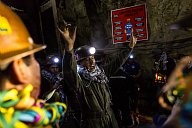
Bolivia - Oruro Carnival
Chris Huby / Le Pictorium
LePictorium_0174089.jpg
February 2017 - Bolivia / Oruro - Miners at the San José mine drink a lot of alcohol before starting their pagan ceremony - Fridays, carnival eve, San José miners hire a banda (musicians) and a spiritual guide (Yatari) to follow their ancestral ceremony which aims to make offerings to the devil (El Tio) to obtain his benevolence - El Tio ("The Uncle") is a god of the underworld and hell according to a popular belief. The carnival of Oruro is the biggest annual cultural event of Bolivia. Carnival celebrated in the city of Oruro, the capital of folklore of the country, it is part of the festival Ito in honor of the Uru people. "The Oruro Carnival" was inscribed in 2008 by UNESCO on the Representative List of the Intangible Cultural Heritage of Humanity.
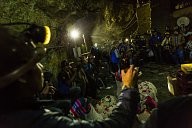
Bolivia - Oruro Carnival
Chris Huby / Le Pictorium
LePictorium_0174090.jpg
February 2017 - Bolivia / Oruro - Miners at the San José mine drink a lot of alcohol before starting their pagan ceremony - Fridays, carnival eve, San José miners hire a banda (musicians) and a spiritual guide (Yatari) to follow their ancestral ceremony which aims to make offerings to the devil (El Tio) to obtain his benevolence - El Tio ("The Uncle") is a god of the underworld and hell according to a popular belief. The carnival of Oruro is the biggest annual cultural event of Bolivia. Carnival celebrated in the city of Oruro, the capital of folklore of the country, it is part of the festival Ito in honor of the Uru people. "The Oruro Carnival" was inscribed in 2008 by UNESCO on the Representative List of the Intangible Cultural Heritage of Humanity.
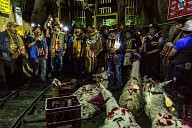
Bolivia - Oruro Carnival
Chris Huby / Le Pictorium
LePictorium_0174091.jpg
February 2017 - Bolivia / Oruro - Miners surround llamas ready to be sacrificed for the devil in their mine - On Friday, carnival eve, miners in San José hired a banda (musicians) and spiritual guide (Yatari) to follow their ancestral ceremony which aims at making offerings to the devil (El Tio) to obtain its benevolence - El Tio ("The Uncle") is a god of the underworld and hell according to a popular belief. The carnival of Oruro is the biggest annual cultural event of Bolivia. Carnival celebrated in the city of Oruro, the capital of folklore of the country, it is part of the festival Ito in honor of the Uru people. "The Oruro Carnival" was inscribed in 2008 by UNESCO on the Representative List of the Intangible Cultural Heritage of Humanity.
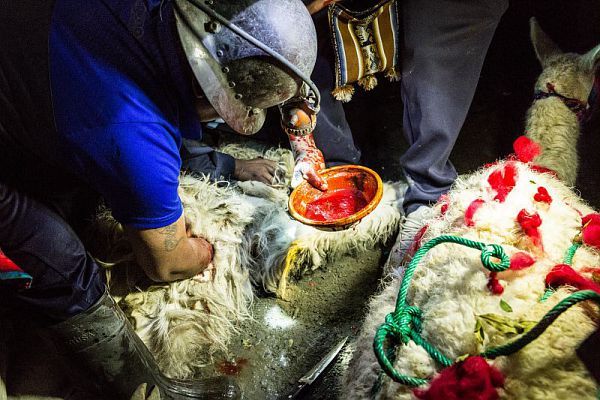
Bolivia - Oruro Carnival
Chris Huby / Le Pictorium
LePictorium_0174092.jpg
February 2017 - Bolivia / Oruro - A miner slaughters a lama destined for sacrifice and fetches his heart to tear him away - On Friday, carnival eve, the miners of San José hired a banda (musicians) and a spiritual guide (the Yatari ) to follow their ancestral ceremony which aims to make offerings to the devil (El Tio) to obtain his benevolence - El Tio ("The Uncle") is a god of the underworld and hell according to a popular belief. The carnival of Oruro is the biggest annual cultural event of Bolivia. Carnival celebrated in the city of Oruro, the capital of folklore of the country, it is part of the festival Ito in honor of the Uru people. "The Oruro Carnival" was inscribed in 2008 by UNESCO on the Representative List of the Intangible Cultural Heritage of Humanity.
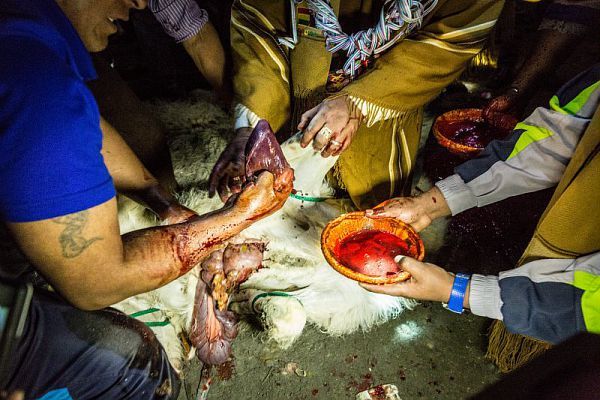
Bolivia - Oruro Carnival
Chris Huby / Le Pictorium
LePictorium_0174093.jpg
February 2017 - Bolivia / Oruro - A miner slaughters a lama destined for sacrifice and fetches his heart to tear him away - On Friday, carnival eve, the miners of San José hired a banda (musicians) and a spiritual guide (the Yatari ) to follow their ancestral ceremony which aims to make offerings to the devil (El Tio) to obtain his benevolence - El Tio ("The Uncle") is a god of the underworld and hell according to a popular belief. The carnival of Oruro is the biggest annual cultural event of Bolivia. Carnival celebrated in the city of Oruro, the capital of folklore of the country, it is part of the festival Ito in honor of the Uru people. "The Oruro Carnival" was inscribed in 2008 by UNESCO on the Representative List of the Intangible Cultural Heritage of Humanity.

Bolivia - Oruro Carnival
Chris Huby / Le Pictorium
LePictorium_0174094.jpg
February 2017 - Bolivia / Oruro - Miners observe the throbbing heart of a lama sacrificed at a pagan ceremony - On Friday, carnival eve, the miners of San José hired a banda (musicians) and a spiritual guide (the Yatari) to follow their ancestral ceremony which aims to make offerings to the devil (El Tio) to obtain his benevolence - El Tio ("The Uncle") is a god of the underworld and hell according to a popular belief. The carnival of Oruro is the biggest annual cultural event of Bolivia. Carnival celebrated in the city of Oruro, the capital of folklore of the country, it is part of the festival Ito in honor of the Uru people. "The Oruro Carnival" was inscribed in 2008 by UNESCO on the Representative List of the Intangible Cultural Heritage of Humanity.
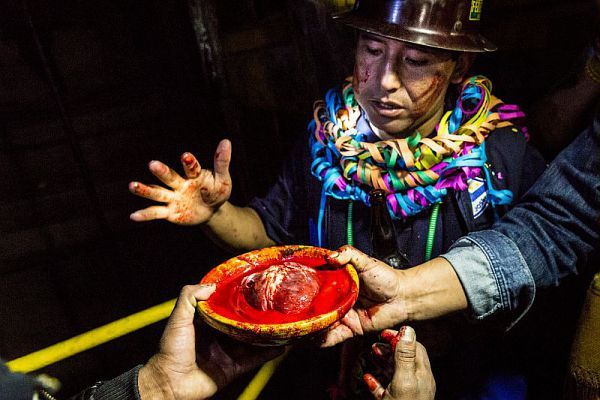
Bolivia - Oruro Carnival
Chris Huby / Le Pictorium
LePictorium_0174095.jpg
February 2017 - Bolivia / Oruro - Miners observe the throbbing heart of a lama sacrificed at a pagan ceremony - On Friday, carnival eve, the miners of San José hired a banda (musicians) and a spiritual guide (the Yatari) to follow their ancestral ceremony which aims to make offerings to the devil (El Tio) to obtain his benevolence - El Tio ("The Uncle") is a god of the underworld and hell according to a popular belief. The carnival of Oruro is the biggest annual cultural event of Bolivia. Carnival celebrated in the city of Oruro, the capital of folklore of the country, it is part of the festival Ito in honor of the Uru people. "The Oruro Carnival" was inscribed in 2008 by UNESCO on the Representative List of the Intangible Cultural Heritage of Humanity.
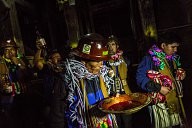
Bolivia - Oruro Carnival
Chris Huby / Le Pictorium
LePictorium_0174096.jpg
February 2017 - Bolivia / Oruro - Miners celebrate and drink pagan ceremony - On Friday, carnival eve, miners in San José hired a banda (musicians) and a spiritual guide (Yatari) to follow their ancestral ceremony to make offerings to the devil (El Tio) to obtain his benevolence - El Tio ("The Uncle") is a god of the underworld and hell according to a popular belief. The carnival of Oruro is the biggest annual cultural event of Bolivia. Carnival celebrated in the city of Oruro, the capital of folklore of the country, it is part of the festival Ito in honor of the Uru people. "The Oruro Carnival" was inscribed in 2008 by UNESCO on the Representative List of the Intangible Cultural Heritage of Humanity.
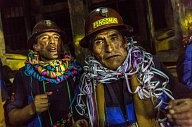
Bolivia - Oruro Carnival
Chris Huby / Le Pictorium
LePictorium_0174097.jpg
February 2017 - Bolivia / Oruro - Miners celebrate and drink pagan ceremony - On Friday, carnival eve, miners in San José hired a banda (musicians) and a spiritual guide (Yatari) to follow their ancestral ceremony to make offerings to the devil (El Tio) to obtain his benevolence - El Tio ("The Uncle") is a god of the underworld and hell according to a popular belief. The carnival of Oruro is the biggest annual cultural event of Bolivia. Carnival celebrated in the city of Oruro, the capital of folklore of the country, it is part of the festival Ito in honor of the Uru people. "The Oruro Carnival" was inscribed in 2008 by UNESCO on the Representative List of the Intangible Cultural Heritage of Humanity.
Next page

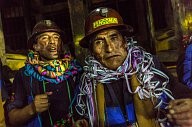 Bolivia - Oruro - The carnival of miners
Bolivia - Oruro - The carnival of miners